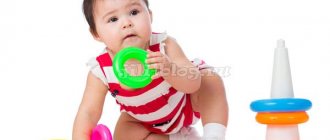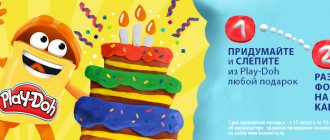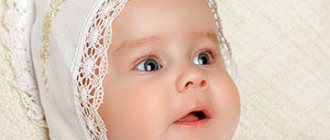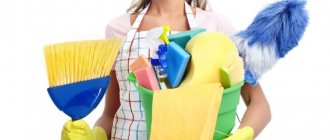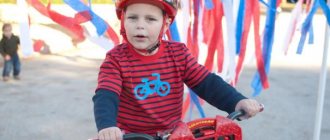At three years old, a child should have learned basic concepts, thanks to which the basic foundation for his intellectual development will be laid. Usually, parents prefer to conduct such classes at home, in a calm environment (since often a three-year-old child has some fear of society and peers: in group classes, many kids look at each other, ready to correct even the correct answer if it differs from someone else’s). What activities should you conduct with three-year-old children?
Classes with a 3-year-old child are an exciting activity: learning colors
Mathematical
What should a child learn?
- Count to five.
- Knowledge of a small number of geometric shapes.
- Basic comparison skills.
- The right pairing.
Remember that at three years old children do not have a long fixation on one subject, so classes must be conducted often and little by little (it is better to conduct three classes for 20 minutes than one for an hour).
Learning shapes from drawings
Developmental activities may include the use of cards, puzzles, copybooks and creative tasks.
Cards
At three years old, your baby can still chew paper, so take the time to laminate the cards so that you don’t have to print out a new set for each lesson. Typically, educational games with children are carried out according to the following scheme: You show the child a card with some image (for children it is better to choose the simplest and most understandable drawings) and ask them to repeat the drawing, or to say how many objects are shown in the picture. If you have a set of paired cards, then you can ask the children to play memory-developing games: “find the pair”, “remember the hidden image”, “find the difference” and so on.
Working with cards solves several problems at once
Remember that such activities can be carried out not only at home, but also on the street.
For example, in the warm season, you can make a treasure hunt game: give your child a real pirate map (with the help of ordinary coffee, the paper can be aged for several years), on which educational cards will be indicated with crosses. Explain to your child that he needs to solve the problem in order to be able to move on.
If you have several children, then you can hold a real competition (remember that each of the children should receive their own incentive prize).
If it is cold outside, then a similar competition can be held at home, having previously hidden all fragile objects.
Puzzles
For three-year-old children, it is best to select large pictures consisting of a small number of details.
Educational puzzles for little ones “Farm”
Cut the educational pictures into vertical lines (they should be quite large). The essence of the lesson is for the child to assemble a puzzle and at the same time learn the name, appearance and location of the number on the number line.
Copybooks
This material will help kids develop their hands, as well as write numbers correctly, freely composing numbers from them. Select the copybooks so that the lines in them are large enough and clear.
Coloring pages
Coloring pages with numbers can be given to children from the age of 3.
They are especially loved by children, so try to use these educational materials as often as possible.
Due to their compactness, coloring books can be used both at home and outdoors at any time of the year. For three-year-old children, try to choose coloring books that use not only the image of a number, but also its written name (this will help train reading and speech).
Types of development activities in younger groups
According to the Federal State Educational Standard (FSES), children aged 1.5–4 years old are provided with educational activities aimed at developing:
- intelligence;
- emotional-volitional sphere;
- attention;
- speeches;
- basic movements;
- creative abilities;
- cultural and hygienic skills (CHS);
- moral and patriotic feelings.
In classes at preschool educational institutions, children learn colors and shapes in a fun way, and also develop creative abilities.
These development vectors in working with children aged 1.5–3 years are implemented in classes on:
- familiarization with the environment (once a week);
- speech development (once a week);
- formation of elementary mathematical concepts (FEMP) (1 time per week);
- physical education (2 times a week);
- fine arts, which includes drawing, modeling and design (once a week);
- music (2 times a week).
This is interesting. This distribution of hours complies with the requirements of the Federal State Educational Standard and the “From birth to school” program, adopted as the basis in most kindergartens in the country.
In the second junior group, 1 hour of design time is added to the list of activities. Otherwise the timing will be identical. However, for pupils aged 3–4 years, the following hours may be included in the educational process:
- choreography (1 or 2 hours);
- with a speech therapist (usually these are group lessons, individual lessons begin in the middle, when the entire scale has already been formed);
- English language;
- environmental education.
This is interesting. The last two courses in the “From Birth to School” program are included in the elective part, which allows you to organize circle work in these areas.
Developmental tasks for all types of classes are the same; depending on the nature of the educational activity, only the emphasis in the work changes
brain teaser
What should a child learn?
- Finding and justifying errors.
- Finding similarities and differences.
- Memorizing words and pictures.
- Concentration of attention.
The latter is especially important: classes with many three-year-old children are complicated by the fact that the child needs a lot of physical activity, and if it is not given, the baby shows his dissatisfaction in the form of crying and hysterics. That is why plan your classes wisely: no more than 20 minutes, and 10 minutes after the start of the class it is recommended to do a short physical exercise minute.
Game activities can be done anywhere
If you study at home, you can, as a reward for active work, go for a walk with your offspring wherever he wants.
Play with your child in associations and opposites as often as possible (this way, reaction speed, verbal and logical thinking are trained). Fairy tales are especially relevant for three-year-old children, so tell a fairy tale with a small mistake that needs to be corrected (for example, the time of year is summer, and the narrator says: “today we went sledding”).
Outdoor games can be educational
If you study at home, give your child several cards with different objects, offering to add the missing ones - this way you will further develop the children’s imagination.
Features of development of a 3-year-old child
The third year of a little person’s life can be considered as another step towards achieving social significance. We can say that a three-year-old child becomes a junior preschooler. At this time, active personality formation occurs. At this time, the phrase “I myself” is increasingly heard from him; he believes that others should perceive him as an equal and take into account his opinion.
Games help a child explore the world
It is important that parents understand the characteristics of this age and support the child in his quest for independence by conducting developmental activities with a 3-year-old child. He looks at the world around him not as a beautiful picture, as it was in the past. At this age, he tries to express himself in specific actions, to express his significance through actions.
Note! Children in the third year of life are aware of their desires and understand what goals they are striving for. It is important that parents treat these features with understanding, providing the baby with a variety of opportunities for activity and self-expression at home.
At this stage of life, great opportunities open up to help the child’s development by involving him in various home games (for modeling, drawing, design, and other activities). This is a favorable time to lay the foundation of personality, promoting the development of thinking, speech, perception, memory and attention, helping to form perseverance, hard work, and teaching self-care skills.
Speech
What should a child learn?
- Sentences must be at least 5-6 words.
- The child must be able to name his personal information.
- Clearly distinguishing the characteristics of an object.
- Knowledge of several actions (walks, cries, talks, meows, etc.).
Speech lesson in front of a mirror
If you practice at home, prepare cubes or cards with letters so that your baby continues to form words from them.
Remember that three-year-old children still do not have very well developed memory, so do not ask your child to spell out complex words or repeat long sentences
MUSICAL GAMES
Useful and exciting activities for kids can be varied. Children especially like games for children with music. With their help, babies learn to control their movements and feel a given rhythm. At home with your child, you can simply play music and introduce him to musical instruments.
"RAIN"
The adult invites the child to reproduce the sound of rain using cubes, but clarifies that it will be either strong or small. The baby must grasp the tempo and pitch of the sound.
“WHAT INSTRUMENT DO I PLAY?”
Parents prepare musical instruments, name each one, and play the sound. Then the toy hides and plays one by one - the child guesses which instrument. You can use the following tools:
- pipe,
- whistle,
- glockenspiel.
Household
What should a child learn?
- Putting on clothes independently.
- Cutting out pictures.
- Coloring pictures.
- Knowledge of basic rules of accuracy.
At 3 years old, a child needs to be taught self-care.
If classes are held at home, then hang posters with hygiene rules throughout the apartment - when passing by them, the child will subconsciously remember them (remember that a child of three years old can be taught very quickly, but a teenager of 16-17 years old nothing can be taught anymore).
Also strive to develop creativity in your son or daughter: at least once every 2-3 months, organize themed parties, for which you can prepare costumes, decorations, scripts and even simple dishes.
In this way, you will gradually encourage your baby to live independently, developing creativity in the meantime.
If you don’t have enough time to carry out such events, then try to at least sometimes prepare crafts from ordinary household items: birds from cups, houses from boxes, and so on.
ROLE-PLAYING GAMES
By bringing dolls and animals to life, and acting out life situations, children learn to interact in a team, find solutions to assigned problems, and express their mood and interests. By influencing this area of a child’s activity, adults can discern and correct mistakes made in raising a child, instill generally accepted norms of behavior, and form the right habits and attitude towards others.
"MOTHERS AND DAUGHTERS"
Girls always want to try on the role of an adult mother who takes care of her baby, feeds her, takes her for a walk, puts her to bed.
"HOME CONSTRUCTION"
A plot that allows you to expand your child’s horizons with knowledge about construction equipment and professions. The little ones are involved in the process of creating a beautiful interior and home comfort, the boys try on the role of the head of the family.
Cognitive
What should a child learn?
- Names of several animals.
- Names of various plants.
- The difference between vegetables and fruits, berries and mushrooms.
- Knowledge of basic natural phenomena.
- Knowledge of the seasons and days.
Classes with cereals teach accuracy.
Prepare cards in advance with images of various birds, animals and plants.
At the same time, try to choose those creatures that are found specifically in your city, so that during a walk you can show your child a bird or animal and tell something interesting about them (do not try to load your child with incomprehensible and complex facts, instead telling interesting stories and stories).
DEVELOPING MEMORY
SHOP
Give your child the task of going to a virtual store and buying a number of products and things. Each time you send it to the store, increase the list. If he brought the wrong thing or forgot something, it is important to help him with leading questions.
MEMORY NOTE
We arrange different objects in a row. The child must remember their location, and you must either remove the object or swap the objects with each other. The child will have to indicate what has changed in the row.
ARTIST
Draw a simple pattern with it. Let him take a good look at it. Then remove the picture and ask him to reproduce it himself. You can use ready-made patterns from the Little Designer set.
Of course, games based on the famous principle of “Memo” and Mimi “Memo” are suitable for developing the baby’s memory.
A wide selection of didactic games in the Big Book on Memory Development.
Sports
Physical development is as important for a baby as intellectual development. This is due to the fact that when the child goes to school, he will not only have physical education lessons, in which he must complete all the tasks for agility, strength and endurance, but also outdoor games with classmates during breaks. if for some reason the child is unable to take part in them, then the number of his possible friends risks being reduced.
Every morning, start with simple exercises, including exercises to warm up your muscles, stretching and the obligatory light jogging.
Kids love sports activities very much.
If you have a daughter, then include a variety of dances in the program - usually little ones like them, while boys prefer ball games and jumping.
Be sure to use exercise equipment: jump ropes, a variety of balls, children's dumbbells, bright hoops and gymnastic mats - all this will help the child perform the exercise with greater quality and pleasure, while reducing the risk of injury.
Subscribe
Detki.guru on Telegram
Leave a comment
Tasks and exercises for the development of children 3-4 years old
For the physical and mental development of the baby, the program should include a variety of play activities.
Mathematical
At this age, the child can be introduced to ordinal counting from one to five. By inviting him to lay out familiar numbers from pebbles, you can reinforce his knowledge of what they look like.
Drawing lesson in the senior group of a preschool educational institution on the topic “Flowers for Mom”
Note! To study numbers, you can create simple problems, the solution of which is based on simple reasoning. For example, ask the child to match an object or find an extra object in a given set.
Speech
The child is able to understand speech addressed to him well. He can formulate his thoughts by forming simple sentences. In order for him to learn to speak better, you can perform articulation exercises with him and learn simple speeches.
Household
You can ask questions, describing the properties of an object so that the child names it.
Note! Considering everyday situations, the plots of fairy tales or cartoons, you can ask your child about what happened first and what happened next, and teach him to correctly perceive the sequence of events.
brain teaser
The child can be offered images of objects or figures and given tasks to find those that correspond to certain characteristics, or be asked to compose a set of those that have a certain property.
Cognitive
A three-year-old toddler is at the age when he is actively interested in the world around him and asks a lot of questions.
You can print out special cards to help him master the world around him.
A child masters the world around him in play
Important! When a child is three or four years old, it is necessary to try, if possible, to answer all the questions asked, give basic knowledge about the environment, and talk about objects, animals, and plants.
When introducing a child to fairy tales, it is useful to give him basic information about what good and evil are, and to develop an understanding of how to act.
Sports
To develop the physical qualities of a toddler, you can use a variety of outdoor games:
- walking along a path of complex shape, over bumps or logs;
- conducting round dances or practicing the simplest types of dances;
- climbing through man-made tunnels or along a wall specially adapted for this;
- peekaboo;
- jumping rope or playing hopscotch.
